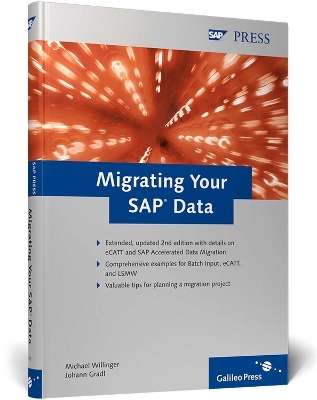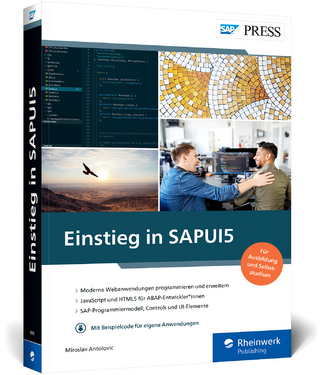
Migrating Your SAP Data
SAP Press (Verlag)
978-1-59229-170-0 (ISBN)
- Titel ist leider vergriffen;
keine Neuauflage - Artikel merken
Michael Willinger was born in 1971 in Heidelberg, Germany. He studied business administration at the University of Mannheim from 1990 to 1996, focusing on bank management, financing, auditing, fiduciary structures, and statistics. He first encountered SAP R/3 during his graduate studies in business data processing; it has had a major impact on his career path ever since. From 1998 to 2001, Michael Willinger worked as an SAP consultant (focus: Financial Accounting) at Bilfinger & Berger AG, a construction firm, before he moved to Tarkett Sommer Holding, an internationally active manufacturer of flooring. At present, he is the project manager for the global implementation of the R/3 Financial Accounting and Controlling modules. Johann Gradl was born in 1961. He studied mathematics and computer science at the Technische Universitat Munchen (Munich Polytechnic University) from 1980 to 1986 and--after a hiatus during which he performed his civil service duty--he completed his doctorate in mathematics from 1988 to 1990. Johann Gradl joined SAP in 1993. He initially worked in the R/2 Services department, and then turned his attention to the area of data migration. He was a driving force behind the development o f the Legacy Sy stem Migration Workbench described in this book. He subsequently performed various tasks related to the development of Customer Relationship Management (CRM). In his current position of Vice President for Installed Base Maintenance & Support, he is responsible for the products CRM and BW, among others.
1 ... Introduction ... 13 2 ... Managerial Foundations for Migrating Data to SAP ERP ... 21 ... 2.1 ... Data Migration as a Subproject ... 21 ... 2.2 ... Preliminary Considerations ... 23 ... 2.3 ... The Data Migration Process from the Project Perspective ... 33 3 ... Technical Basics for Migrating Data to SAP ERP ... 41 ... 3.1 ... Basic Terminology ... 41 ... 3.2 ... The Data Migration Process from a Technical Perspective ... 42 ... 3.3 ... Overview of Technical Procedures for Data Migration ... 48 4 ... Batch Input ... 51 ... 4.1 ... What Is Batch Input Processing? ... 51 ... 4.2 ... How Does Batch Input Work? ... 51 ... 4.3 ... Standard Batch Input Programs ... 59 ... 4.4 ... Batch Input Recording: General Approach ... 63 ... 4.5 ... Batch Input Recording Combined with Microsoft Word Mail Merge Processing ... 84 5 ... Extended Computer Aided Test Tool (eCATT) ... 99 ... 5.1 ... What Is the eCATT? ... 99 ... 5.2 ... History of the eCATT ... 99 ... 5.3 ... Availability and Functionality of eCATT and CATT ... 101 ... 5.4 ... Preparing the System for Using the eCATT ... 102 ... 5.5 ... How Does the eCATT Work? ... 105 ... 5.6 ... How Can You Use the eCATT for Data Migration? ... 121 ... 5.7 ... Tips and Tricks ... 138 6 ... Computer Aided Test Tool (CATT) ... 147 ... 6.1 ... Basic Terminology ... 147 ... 6.2 ... Preparing the System for Using the CATT ... 148 ... 6.3 ... How Does the CATT Work? ... 148 7 ... Legacy System Migration Workbench ... 167 ... 7.1 ... Overview of the LSM Workbench ... 167 ... 7.2 ... Data Migration with the LSM Workbench ... 170 ... 7.3 ... Recordings ... 228 ... 7.4 ... Long Texts ... 237 ... 7.5 ... Periodic Data Transfer ... 243 ... 7.6 ... Transporting Projects ... 247 ... 7.7 ... Preparations for Using IDoc Inbound Processing ... 249 ... 7.8 ... Advanced LSM Workbench Features ... 252 ... 7.9 ... Tips and Tricks ... 256 ... 7.10 ... Summary ... 261 8 SAP Accelerated Data Migration ... 263 ... 8.1 ... Availability ... 263 ... 8.2 ... Overview of SAP ADM ... 264 ... 8.3 ... Specific Features ... 265 ... 8.4 ... Overview of the Typical Process ... 267 ... 8.5 ... Typical Process in Detail: Process Cockpit ... 268 ... 8.6 ... Development Cockpit ... 276 ... 8.7 ... Checklist for SAP ADM ... 280 ... 8.8 ... Additional Information on SAP ADM ... 280 9 ... Techniques for Avoiding Programming ... 281 ... 9.1 ... Problem Area: Data Conversion ... 281 ... 9.2 ... Techniques for Converting Data ... 282 ... 9.3 ... Summary ... 301 10 ... Assessment of Data Migration Techniques ... 303 ... 10.1 ... Advantages and Disadvantages of the Procedures ... 303 ... 10.2 ... Reasons for Favoring a Certain Procedure ... 308 11 Migrating Fixed Assets with Microsoft Excel ... 315/b> ... 11.1 ... Assessment of Procedures for Migrating Fixed Assets ... 315 ... 11.2 ... Types of Legacy Data Transfer ... 319 ... 11.3 ... Case Example: Migrating Fixed Assets with Microsoft Excel ... 322 ... 11.4 ... Preparing to Go Live ... 338 12 ... Outlook and Related Areas ... 341 ... 12.1 ... Data Transfer Workbench ... 341 ... 12.2 ... Data Migration Between SAP ERP Systems or within an SAP ERP System ... 345 ... 12.3 ... Data Migration in SAP CRM ... 347 Appendix ... 351 A SAP ERP Tables for Selected Master and Transaction Data ... 353 ... A.1 Financial Accounting ... 353 ... A.2 Controlling ... 354 ... A.3 Logistics ... 354 B Glossary ... 357 C The Authors ... 365 Index ... 367
| Erscheint lt. Verlag | 1.4.2008 |
|---|---|
| Reihe/Serie | SAP Press |
| Verlagsort | Maryland |
| Sprache | englisch |
| Maße | 1680 x 240 mm |
| Einbandart | gebunden |
| Themenwelt | Mathematik / Informatik ► Informatik ► Netzwerke |
| Informatik ► Weitere Themen ► SAP | |
| ISBN-10 | 1-59229-170-8 / 1592291708 |
| ISBN-13 | 978-1-59229-170-0 / 9781592291700 |
| Zustand | Neuware |
| Informationen gemäß Produktsicherheitsverordnung (GPSR) | |
| Haben Sie eine Frage zum Produkt? |
aus dem Bereich


